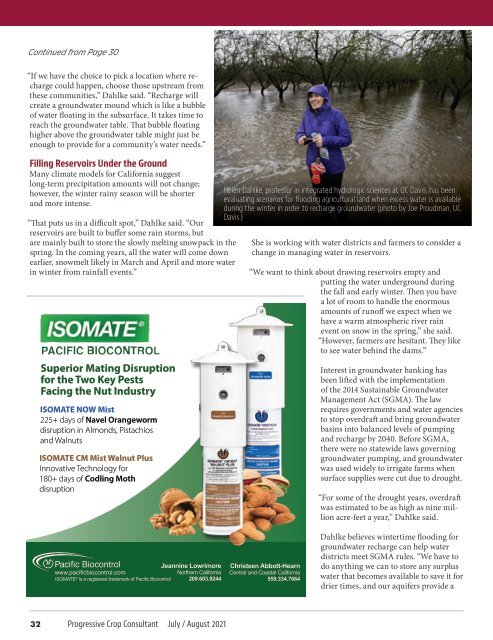PCC June July 2021 e
You also want an ePaper? Increase the reach of your titles
YUMPU automatically turns print PDFs into web optimized ePapers that Google loves.
Continued from Page 30<br />
“If we have the choice to pick a location where recharge<br />
could happen, choose those upstream from<br />
these communities,” Dahlke said. “Recharge will<br />
create a groundwater mound which is like a bubble<br />
of water floating in the subsurface. It takes time to<br />
reach the groundwater table. That bubble floating<br />
higher above the groundwater table might just be<br />
enough to provide for a community’s water needs.”<br />
Filling Reservoirs Under the Ground<br />
Many climate models for California suggest<br />
long-term precipitation amounts will not change;<br />
however, the winter rainy season will be shorter<br />
and more intense.<br />
“That puts us in a difficult spot,” Dahlke said. “Our<br />
reservoirs are built to buffer some rain storms, but<br />
are mainly built to store the slowly melting snowpack in the<br />
spring. In the coming years, all the water will come down<br />
earlier, snowmelt likely in March and April and more water<br />
in winter from rainfall events.”<br />
Superior Mating Disruption<br />
for the Two Key Pests<br />
Facing the Nut Industry<br />
ISOMATE NOW Mist<br />
225+ days of Navel Orangeworm<br />
disruption in Almonds, Pistachios<br />
and Walnuts<br />
ISOMATE CM Mist Walnut Plus<br />
Innovative Technology for<br />
180+ days of Codling Moth<br />
disruption<br />
®<br />
Helen Dahlke, professor in integrated hydrologic sciences at UC Davis, has been<br />
evaluating scenarios for flooding agricultural land when excess water is available<br />
during the winter in order to recharge groundwater (photo by Joe Proudman, UC<br />
Davis.)<br />
She is working with water districts and farmers to consider a<br />
change in managing water in reservoirs.<br />
“We want to think about drawing reservoirs empty and<br />
putting the water underground during<br />
the fall and early winter. Then you have<br />
a lot of room to handle the enormous<br />
amounts of runoff we expect when we<br />
have a warm atmospheric river rain<br />
event on snow in the spring,” she said.<br />
“However, farmers are hesitant. They like<br />
to see water behind the dams.”<br />
Interest in groundwater banking has<br />
been lifted with the implementation<br />
of the 2014 Sustainable Groundwater<br />
Management Act (SGMA). The law<br />
requires governments and water agencies<br />
to stop overdraft and bring groundwater<br />
basins into balanced levels of pumping<br />
and recharge by 2040. Before SGMA,<br />
there were no statewide laws governing<br />
groundwater pumping, and groundwater<br />
was used widely to irrigate farms when<br />
surface supplies were cut due to drought.<br />
“For some of the drought years, overdraft<br />
was estimated to be as high as nine million<br />
acre-feet a year,” Dahlke said.<br />
Jeannine Lowrimore<br />
www.pacificbiocontrol.com<br />
Northern California<br />
ISOMATE ® is a registered trademark of Pacific Biocontrol 209.603.9244<br />
Christeen Abbott-Hearn<br />
Central and Coastal California<br />
559.334.7664<br />
Dahlke believes wintertime flooding for<br />
groundwater recharge can help water<br />
districts meet SGMA rules. “We have to<br />
do anything we can to store any surplus<br />
water that becomes available to save it for<br />
drier times, and our aquifers provide a<br />
32 Progressive Crop Consultant <strong>July</strong> / August <strong>2021</strong>

















